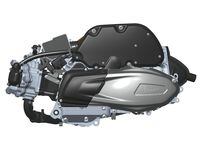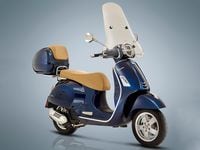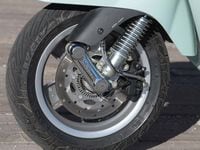Piaggio renewed its top Vespa model line in 2005, introducing the GT 200 (72mm bore by 48.6mm stroke, actual displacement 198cc, 19.7 hp at 8,500 rpm, 7.1 pound-feet at 6,000 rpm). It was the product of a meaningful evolution of previous-generation Vespas, and it was the first that adopted the new liquid-cooled, fuel-injected, SOHC, four-valve single, together with 12-inch wheels and fatter tires, replacing the old 10-inch skinny rubbers. And with the larger wheels came the extra safety of 220mm disc brakes, front and rear. A huge revolution indeed. The real revolution was in the steel sheet unibody structure that, though unchanged in its iconic style, was light-years ahead of all previous Vespas in terms of torsional rigidity.
Suddenly the Vespa offered much more precise steering response, neater handling manners that "talked to you," being also immensely more stable at speed and more neutral into line. The new structure body set the cornerstone for a solid escalation in performance that affirmed its credibility, with the creation of the following GTS 250 (bore 72mm, stroke 60mm, actual displacement 244cc, 21.2 hp at 8,250 rpm, 14,8 pound-feet at 6,500 rpm). In 2007, the GTS 250 unit evolved into that of the GTS 300 (bore 75mm, stroke 63mm, actual displacement 278cc, 21.2 hp at 7,750 rpm, 16.2 pound-feet at 5,000 rpm). As you can see from the numbers, the GTS 300 only offered higher torque at lower rpm, which was all the Vespa GTS needed to sprint off at the lights with extra zest, the right extra performance for an urban commuter like this. The Vespa GTS 300 remained unchanged in its mechanical components until 2018, only adding versions that were identified by different dressing and components: GTS Touring, GTS Super, GTS SuperSport. But basically they were all Vespa GTS 300.
When rumors circulated about a further hotter version of the Vespa, I presumed Piaggio would fit its excellent 30-plus-hp SOHC 350cc to its icon to create the ultimate Super Vespa. Rather, when the time came to upgrade to Euro 4 emission standards, the company also polished the 278cc engine of the GTS 300 to improve its power and torque to the highest level ever installed on a Vespa. The GTS 300 powerplant has undergone a very substantial redesigning, to the point that it has been renamed 300 HPE (High Performance Engine).
Displacement measurement factors remain unchanged, while new castings were developed for the head to obtain superior performance in thermodynamic efficiency. The new head features larger and more accurately profiled inlet and exhaust ports. The valves are 3mm larger in diameter and the combustion chamber has been reshaped, in particular in its lower half section represented by the piston top. In addition, Piaggio has reduced the losses caused by friction, firstly by redesigning the SOHC valve train with the adoption of roller-type rocker arms teamed with high-lift cam profiles. The final addition is represented by a new multi-hole injector operating at higher pressure and inserted in an inlet runner which has been optimized in length and shape to further increase the volumetric efficiency and fatten the torque curve.
The 300 HPE unit delivers a claimed 23.8 hp at 8,250 rpm while peak torque is increased by a whopping 18 percent, to 19.2 pound-feet at 5,250 rpm. Peak power and peak torque are separated by a range of 3,000 rpm—a remarkable and strong confirmation of the high efficiency of the new 300 HPE unit. To get the best out of HPE, the CVT transmission has been refined in its centrifugally actuated automatic clutch and the dimensioning of the belt and related expansible pulleys.
The Vespa GTS has been slightly revised in its styling with the addition of a horizontal rib that runs across the shield just above the front fender. It does not alter the iconic Vespa styling, but it is there and it looks good. LED lights have been adopted front and rear, while the electronics suite has been further upgraded with the adoption of the Vespa Mia platform that, via Bluetooth, connects personal smartphones to the Vespa GTS’ electronics suite. This, with the addition of the new Vespa app, connects iOS and Android mobiles to all Vespa models equipped with TFT display instrumentation. In the new GTS 300’s case, it will be the SuperTech version, which is the one featuring a 4.3-inch TFT display.
The other versions are GTS 300 (base model), GTS Touring, GTS Super, and GTS SuperSport. The only one that is immediately identifiable is the GTS Touring, featuring a mini fairing and a luggage rack in the back. The others have subtle specific finishing touches: colors, wheels style, seat trim, or front suspension spring color. From a technical point of view they are all the same.
I extensively tested the new Vespa GTS 300 both in town and on open roads and I must say I was surprised by the very vigorous throttle response. In town, the Vespa GTS 300 is king of being quick off the line to the point that, on humid surfaces, I appreciated the ASR traction control system which is standard equipment on all GTS 300 models.
The engine-CVT transmission package is very effective, precise, and easy to manage; the chassis offers good balance and controllability even at very low speed sneaking through cars packed in at stoplights. The steering is quick but solid and precise. It’s here also I notice a positive evolution over the previous edition of the GTS 300. I felt perfectly secure even swinging through traffic at 30 to 40 mph, on the cobblestone-paved streets of downtown Milan. And the front and rear disc brake systems are powerful and free from any lock-up tendencies.
On the open road, the Vespa GTS 300 revealed all the extra punch it has in reserve during a spirited ride on a twisty back road. The throttle response is gratifying and ensures quick and safe passing, with the progression that remains very strong even from 50 all the way to top speed—I clocked at about 74 mph—despite my wider frontal area in a lightly padded rain jacket.
The riding posture is ergonomically correct and the seat is well padded and comfortably profiled, though I never take full advantage of the full contact area since I’d rather sit as forward as naturally comfortable, to add extra weight to the front end for extra stability and tightness of steering response.
The Vespa GTS 300 is the result of yet another fundamental evolutionary step applied to a concept born in 1946, one that keeps being improved with great determination and competence to approach the status of "perfect scooter." No surprise that Vespa continues to enjoy success in the face of a multi-shaped and multi-sized competition.








/cloudfront-us-east-1.images.arcpublishing.com/octane/N575KB7BDZDPPJBRLZRG2ANHKI.jpg)
/cloudfront-us-east-1.images.arcpublishing.com/octane/T77HXRXV4NGKDNZODMSEIBRXPE.jpg)
/cloudfront-us-east-1.images.arcpublishing.com/octane/NKMM7V2P3BCSXAV6J56FKK67OU.jpg)
/cloudfront-us-east-1.images.arcpublishing.com/octane/SWQRQV27DNFA7LXGFI7FNFNGOQ.jpg)
/cloudfront-us-east-1.images.arcpublishing.com/octane/GYEXUJBV5JGQLLZNXO7KRVSTEY.jpg)
/cloudfront-us-east-1.images.arcpublishing.com/octane/MCWUSJJVJVG45P7QQG3WOXZR54.jpg)
/cloudfront-us-east-1.images.arcpublishing.com/octane/AJ4EFPH2CRDURDAB5LPEA2V2NE.jpg)
/cloudfront-us-east-1.images.arcpublishing.com/octane/LSDHIL22SZAFFPYLKP5ZXLJSIY.jpg)
/cloudfront-us-east-1.images.arcpublishing.com/octane/SH46HIOX4RELXLXF6AE3SFGH4A.jpg)
/cloudfront-us-east-1.images.arcpublishing.com/octane/JUZ52WFWLJGMNH7PGZNOKP3MUY.jpg)












